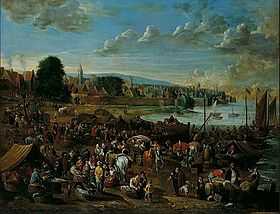Alexander van Bredael
Alexander van Bredael (1 April 1663 – 14 July 1720) was a Flemish painter known for Italianate landscapes and genre scenes of fairs, cattle markets and villages.[1] He was a prominent member of the Antwerp artistic family van Bredael.
Life

He was born in Antwerp into an artist family as the son of Peeter van Bredael, a well-known painter specializing in market scenes and village feasts set in Italianate landscapes.[2] His mother was An Veldener, the daughter of the sculptor Jennyn Veldener.[3] Two of his brothers, Jan Peeter the Elder and Joris became painters.[2] Alexander trained under his father.[4] He became a master in the Antwerp Guild of Saint Luke in 1685.[5]
On 11 August 1685, he married Cornelia, daughter of the Antwerp history painter Hubert Sporckmans. They had seven children of whom Jan Frans became a painter.[3] Alexander van Bredael died in Antwerp.
His pupils include his son Jan Frans, Peeter Busschop, Johan Baptist Govaerts, Guielmus van Ryn and Pieter Snyers.[1]
Work
Alexander van Bredael painted in a wide variety of genres including cattle market scenes, Italianate landscapes and village scenes. He is probably best known for his depiction of festivals and processions set in his native Antwerp.[4] His village scenes are reminiscent of the genre scenes of David Teniers the Younger.[1] He also took his inspiration from other Flemish artists. For instance, his composition A Festival in Antwerp likely drew its inspiration from similar paintings by Flemish artists such as Pieter van Aelst and Erasmus de Bie.[6][7]

He painted many scenes of cattle markets, which offered him the opportunity to showcase his skill in depicting group scenes populated with many figures as well as his ability to paint animals. He made various Italianate landscapes often including harbour scenes such as the Harbour Scene with View of a Town.[8]
He produced designs for the tapestry workshops in Oudenaarde. In 1698 he is recorded as supplying designs for six tapestries with genre scenes depicting peasants and gypsies.[9] He provided designs for tapestries that are referred to as Teniers scenes or tapestries. This refers to tapestries related to the Flemish genre painters David Teniers the Younger and David Teniers III. Even though it is not possible to connect the tapestries known as Teniers tapestries, which were woven in numerous weaving centers in Flanders, to any specific designs of these genre painters, these tapestries have been called Teniers tapestries since the early 18th century. Correspondences between the merchant Pieter van Verrren and Alexander van Bredael of 1700 make clear Alexander van Bredael designed some Teniers tapestries. A tapestry depicting an eyeglass vendor was sold by Christie’s on 5 February 2003 in New York. It is possible that the landscape in this tapestry was drawn by Pieter Spierinckx, particularly since such a collaboration between Bredael and Spierinckx on Teniers tapestries is mentioned in documents of 1707.[10]
References

- ↑ 1.0 1.1 1.2 Alexander van Bredael (I) at the Netherlands Institute for Art History (Dutch)
- ↑ 2.0 2.1 Walther Bernt, The Netherlandish painters of the seventeenth century, Volume 1, Phaidon, 1970, p. 19
- ↑ 3.0 3.1 Pierre Van Bredael, in: Biographie Nationale Tome 2, p. 914-917 (French)
- ↑ 4.0 4.1 Cattle Market in Antwerp at the vads
- ↑ Alexander van Bredael, Harbour Scene with View of a Town at Lempertz
- ↑ Une procession animée at Musėe de Flandre (French)
- ↑ Peter van Aelst, The Ommegang on the Meir in Antwerp, at Jean Moust
- ↑ Harbour Scene with View of a Town sold at Lempertz on 12 April 2012 in Cologne, lot 1316
- ↑ Mengelmaren in: Biekorf. Jaargang 67. E. Vercruysse en Zoon, St.-Andries 1966, p. 117
- ↑ Alexander van Bredael, An Oudenaarde Teniers Tapestry at Christie's
| Wikimedia Commons has media related to Alexander van Bredael. |